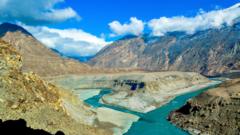As India halts the Indus Waters Treaty in response to a violent incident in Kashmir, questions arise about its ability to manipulate water flows into Pakistan. Experts indicate that physical and infrastructural limitations may hinder India's plans, despite the potential consequences during dry seasons where water availability is critical.
India’s Water Sharing Dilemma: Can It Control the Flow into Pakistan?

India’s Water Sharing Dilemma: Can It Control the Flow into Pakistan?
Following the suspension of the Indus Waters Treaty, experts debate India’s capacity to withhold river water from Pakistan amidst growing tensions.
The Indus river, a lifeline for both India and Pakistan, is once again at the center of a geopolitical debate. Recently, India announced the suspension of the Indus Waters Treaty (IWT), a pivotal agreement governing the distribution of water from the Indus river basin dating back to 1960. This decision comes in the wake of increased hostility between the two nations, following a serious attack in Indian-administered Kashmir that India attributes to cross-border terrorism supported by Pakistan.
The IWT has historically been viewed as a model for trans-boundary water management, having outlasted two major conflicts. Under its terms, India is allocated the rights to three eastern rivers—the Ravi, Beas, and Sutlej—while Pakistan has control over the western rivers, including the Indus, Jhelum, and Chenab. Both nations have lodged complaints in the past regarding water usage violations, stemming primarily from India's hydropower projects, which Pakistan fears will exacerbate its water shortages.
While India pursues modification of the treaty, citing various needs such as shifting climatic conditions and population demands, this recent suspension marks an unprecedented move in the legal landscape of water sharing between the two rivals. Experts express skepticism regarding India's ability to effectively control river flows. The prevalent infrastructure consists of run-of-the-river hydropower plants that do not support significant water storage for diversion.
Prospective modifications to India's existing water management infrastructure could theoretically enhance its capability to retain or redirect water. However, this has proven challenging due to geographic limitations and political pressures, both domestically and internationally. If India were to begin withholding water, such actions could inflict substantial repercussions on Pakistan, particularly during the dry season when water requirements soar.
Another formative aspect of the treaty is the requirement for India to share hydrological data that informs Pakistan’s flood management and agricultural planning. Following the treaty's suspension, India's commitment to this data-sharing appears to diminish, raising alarms in Pakistan regarding the potential risks of water scarcity.
The overarching fear is the possible “weaponization” of water resources, a concept that envisions the upstream nation manipulating water flows to exert control over the downstream country. Although experts caution against the practicality of such actions given India's distance from the border and existing environmental risks, they highlight the emerging complexities of water management in the face of rising geopolitical tensions and climate change.
As disputes over water resources continue to escalate, close monitoring of the situation is imperative, particularly in light of similar behaviors observed from other regional powers, such as China, which has previously leveraged water flows to further its political objectives. In the interconnected realm of climate and geopolitics, water resource management remains an influential and potentially volatile factor in national relations between India and Pakistan.



















